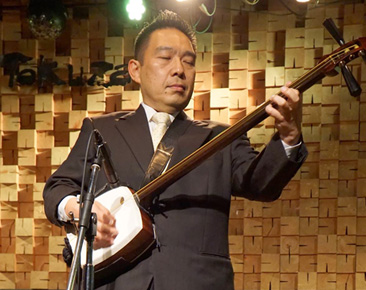
This memorial appreciation is a contribution from Jack Tottle, Associate Professor Emeritus at East Tennessee State University. It is used by permission from Moonshiner magazine (JAPAN), originally published—in Japanese translation—February, 2016.
 Takeharu Kunimoto was among the most unusual, gifted, energetic and hard-working individuals I’ve encountered during my six decades of immersion in bluegrass and traditional American music. I met him in 2003 while serving as the director of East Tennessee State University’s Bluegrass, Old Time and Country Music Program.
Takeharu Kunimoto was among the most unusual, gifted, energetic and hard-working individuals I’ve encountered during my six decades of immersion in bluegrass and traditional American music. I met him in 2003 while serving as the director of East Tennessee State University’s Bluegrass, Old Time and Country Music Program.
The Japanese Government’s Agency for Cultural Affairs had appointed Kunimoto as a “Special Advisor for Cultural Exchange” with a year’s residency in the United States. He applied to East Tennessee State University (ETSU) to study American traditional culture and bluegrass music for that year and was immediately accepted.
We knew Kunimoto was already famous in Japan as a gifted performer and composer in the Japanese traditional art form known as rokyoku, which combines dramatic storytelling, singing, and instrumental music on the Japanese instrument called the shamisen. We also understood he loved bluegrass music and that he could play the mandolin. Beyond that, we had little idea of what to expect.
Kunimoto’s debut performance after arriving in Tennessee was both memorable and astonishing. It occurred with virtually no rehearsal.
He had just flown in from Tokyo the day before the ETSU student Bluegrass Pride Band was booked, on very short notice, to perform for a couple of hours on Bristol TN/VA’s State Street. The street (which separates Tennessee and Virginia) was blocked off for the purpose and a sizeable crowd of hardcore bluegrass fans had gathered for some of their favorite music. No one in the audience or in the ETSU Band had the slightest idea of the what Kunimoto had in store for them.
 Surprise No. 1: Assistant program director Raymond McLain was leading the band. He ran through a couple of bluegrass tunes so Kunimoto could get ready to play breaks on them. Rather than play mandolin he unexpectedly elected to play his shamisen.
Surprise No. 1: Assistant program director Raymond McLain was leading the band. He ran through a couple of bluegrass tunes so Kunimoto could get ready to play breaks on them. Rather than play mandolin he unexpectedly elected to play his shamisen.
Surprise No. 2: The next unforeseen revelation was that Kunimoto had mastered a sizeable vocabulary of bluegrass licks and phrasing to the point that the shamisen blended right in with the bluegrass instruments both on instrumental leads and backup. His instrument had a different tone and timbre, but it fit remarkably well.
Surprise No. 3: Raymond told Kunimoto he’d call him up on stage for a tune or two (as they hadn’t time to rehearse more than a couple of songs). Then he, Kunimoto, could sit down. As arranged, Raymond called him up. Then when Kunimoto was supposed to walk off stage and sit down, he just didn’t!
Kunimoto remained on stage with the band and played excellent improvised breaks on whatever song the band did. No one was sure whether Kunimoto’s grasp of English was such that he didn’t understand that he was supposed to sit down or whether he just figured, “I’m having fun! I can cut it, so I’ll just stay here and keep playing!”
None of the players or onlookers had heard anything like bluegrass shamisen before, but Kunimoto’s solid musicianship, combined with a flair for showmanship quickly won over any doubters. Then he pulled a couple more rabbits out of the hat.
Surprise No. 4. Kunimoto asked Raymond if he could do some traditional rokyoku for his Appalachian audience. Raymond wondered how folks would respond to something so different from what they were used to. Nevertheless, he told Kunimoto, “Go ahead if you want to.”
Part of Kunimoto’s rokyoku repertoire involved high energy argument between two characters, both of whom are played by Kunimoto using hilariously different voices, conversing, arguing and yelling at each other. Even when the American listener has no idea what the Japanese dialog means, it is side-splittingly funny. Far from being put off by the weirdest thing they’d ever heard, the audience laughed heartily and was immediately won over.
Surprise No. 5. Finally Kunimoto pulled out his ultimate show stopper. Settling into a rhythmic rock-and-roll strum on the shamisen, he got the bluegrassers’ feet tapping, heads bobbing, and bodies swaying.
Suddenly he punctuated the music with a wild-sounding cry. Almost immediately he got the audience to answer him back with a passable imitation. Over and over he coaxed everyone into the bizarre call-and-response. Soon we were all dissolving into laughter and joyful applause. All present knew they had witnessed a rare and precious moment brought to them by a unique master artist.
Later Kunimoto told me a bit about his background in music. While still a child, a fortuitous coincidence led Kunimoto to hear Bill Monroe’s Bluegrass Breakdown over the sound system in a Japanese bookstore. (In how many U. S. bookstores could this happen?) The music — totally unlike anything he’d heard previously — both shocked and fascinated the young boy.
Around the age of fourteen, the youngster learned that Bill Monroe, The Father of Bluegrass, was touring Japan. Arriving early at the concert hall — four hours before show time (!) — Kunimoto had the opportunity to meet Monroe, shake the great man’s hand, and to decide he was destined to learn to play the mandolin.
In Kunimoto’s world at the time there were no players, teachers, or even people who knew what bluegrass was. As did many young American players in the early days of bluegrass, the youthful enthusiast undertook the solitary painstaking work of trying to learn the music from records unassisted.
Eventually Kunimoto discovered the Japanese translation of my book, Bluegrass Mandolin, with its detailed description of techniques used in the music. In time Kunimoto became an accomplished bluegrass mandolin player, and, concurrently, a remarkably skilled shamisen player.
 During his year at ETSU Kunimoto assembled his own band, The Last Frontier, comprised of talented ETSU students and alumni. The band’s brilliant performing style won over U. S. audiences with its exuberant music—both bluegrass and just enough Japanese rokyoku to engage and amuse without overwhelming them. Well after the conclusion of his official residency the band toured repeatedly in the United States, Canada and Japan.
During his year at ETSU Kunimoto assembled his own band, The Last Frontier, comprised of talented ETSU students and alumni. The band’s brilliant performing style won over U. S. audiences with its exuberant music—both bluegrass and just enough Japanese rokyoku to engage and amuse without overwhelming them. Well after the conclusion of his official residency the band toured repeatedly in the United States, Canada and Japan.
The group’s banjo player, J. P. Mathes recalls: “In 2007 we played Eigo De Shaberanaito/ Can You Speak English on Japan’s national NHK-TV. We also sold out 4 consecutive shows at the Parco Theater in the Shibuya district of Tokyo.”
After Kunimoto’s untimely passing in December 2015 we still have three remarkable CDs of his music with the Last Frontier. The album titles — Appalachian Shamisen, Sushi and Gravy, and Soy Sauce Blues — playfully reflect the unique blend of cultures on display.
Some of the songs are from the first-generation American bluegrass repertoire of artists like the Stanley Brothers, Bill Monroe, Flatt and Scruggs and the Louvin Brothers. There are also numerous fine pieces written by ETSU musicians J. P. Mathes, Dan Boner, Aaron Jackson, and Raymond McLain. But the most unusual—with titles like Tears of the Samurai, Hiyaku’s Love, Chinese Caravan, Lonesome Yokocho, Dream of a Geisha, and Pray For Asia—are Kunimoto’s own compositions.
Those of us who were touched by Kunimoto and his music will remember him for his revolutionary vision of crossing cultural boundaries with courage, tremendous energy, contagious delight in performing and boundless good will. He remains an inspiration to a great many of us.
Jack Tottle founded East Tennessee State University’s Bluegrass, Old Time and Country Music Program in 1982 and continued to direct it until his retirement in 2006. He is known to many as the founder, in 1975, of Tasty Licks, whose Rounder albums gave Béla Fleck, Pat Enright and Mark Schatz their first national exposure.
Jack’s best-selling instruction book, Bluegrass Mandolin, released that same year, remains in print. Jack is also the composer of dozens of songs recorded and/or performed by Blue Highway, Alison Krauss and Union Station, James King, Tasty Licks, the Payroll Boys, the Lonesome River Boys, the ETSU Bluegrass Band, Mountain Heart, the Bluegrass Cardinals, Tim Stafford, and under his own name as well.
Two albums, the Bluegrass Sound—(Copper Creek) and The Eagle (BHB)—feature Jack playing and singing a total of 32 of his own compositions with along with various musicians including Stuart Duncan, Jerry Douglas, Tony Rice, Ron Block, Tim Stafford, Béla Fleck, Del and Ronnie McCoury, Wayne Taylor, Pat Enright, Charlie Cushman, Mark Schatz, Glen Rose, Dan Boner, Bill Dunham, Raymond McLain and Hunter Berry.
Jack currently lives in North Kohala on the Big Island of Hawaii where he performs from time to time with his band, Bluegrass Jack.







